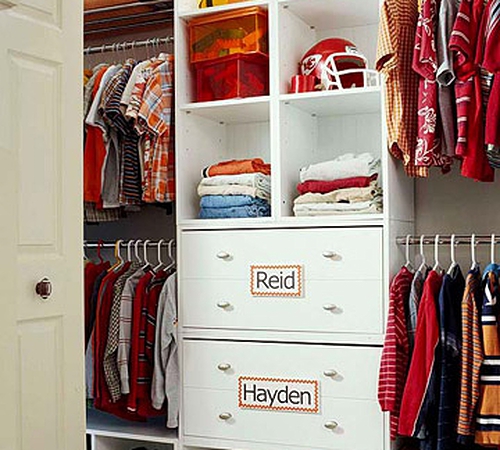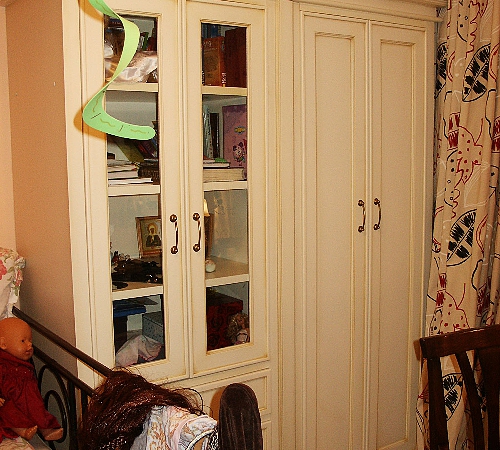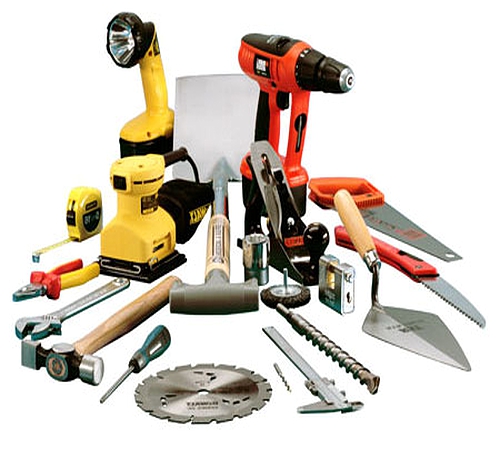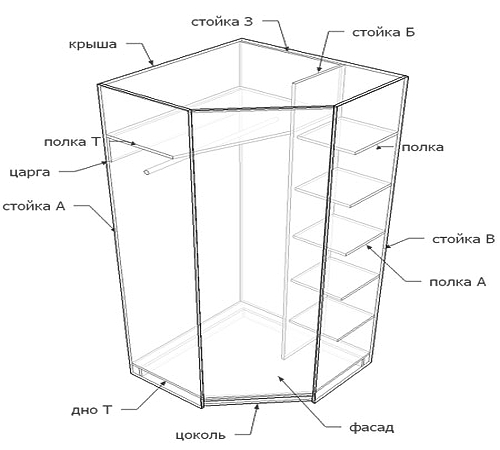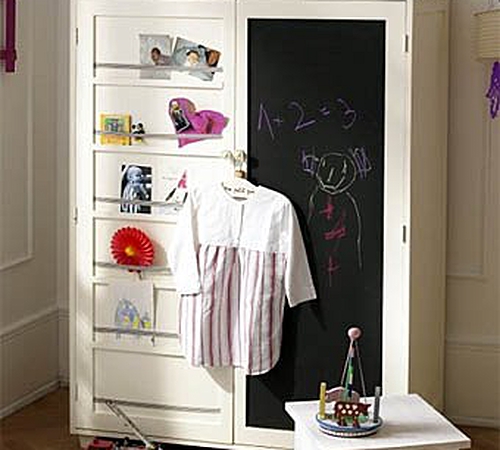A lot of things in his life and everyday life depend on how the child’s room is equipped. It is important that the organization of space in the nursery is aimed at creating the most favorable conditions for the growth, development and comfortable existence of the baby. Usually in his room there is a cavard, things and toys are scattered throughout its area, but if you install a functional, roomy cabinet in which there is a place for all children's property, the problem will be partially resolved. And if you make it with your own hands, you can generally get a lot of advantages.
Content
- Benefits of the children's cabinet with your own hands
- Types of children's cabinets
- Preparation for the beginning of work
- Tools and materials that will be needed for work
- Preparation of the drawing, creating cutting and cutting details
- The cabinet assembly sequence
- Counting funds spent on the purchase of material and accessories for the cabinet
Benefits of the children's cabinet with your own hands
There are a great many pluses, but in this section we will list the main and most important:
-
Personnel manufacturing, both for children and any other furniture, can significantly save on the cost of work, because In this case, you will spend only the purchase of materials.
-
To create furniture for the room of your child, to imagine how his things will be located in it, to calculate the number of shelves is very pleasant and interesting. Such a closet, created by the hands of a loved one, exuding positive energy and the warmth of his hands, will probably fall in love with the child.
-
You can make a cabinet that will fit the size and decor of a particular room.
-
It is possible to study the properties of existing materials and independently make a choice in favor of certain, suitable for you in quality and cost.
Types of children's cabinets
Before making a cabinet in a nursery, you must first think about what it should be to meet your requirements and decide on the model. Consider several main types of children's cabinets:
-
Corner in the nursery. Such a model is simultaneously and spacious and saves space, it is very good for small rooms. For such a cabinet, one corner is enough, and the rest of the space can be used under another furniture. Its doors can be both sash and sliding, depending on individual preferences.
-
Cupil-wardrobe. This model is also very spacious and convenient in that the doors are pushed to the sides. Thanks to this, the cabinet can stand in a rather small or narrow room. He, unlike sorcerers, does not need additional space to open the door. It can be located along the wall, and it can be angular. In the children's closet, it is better not to make mirror facades, because They will constantly show off fingerprints.
-
A cabinet combined with a bed. Often this is a whole multifunctional children's corner, which is also very convenient, if it is necessary to save space. Most often, the bed is located on the second floor, and the steps leading there are simultaneously shelves for things. There are still designs when a bed, a closet, desktop and a bedside table are one and complement each other.
-
Children's cabinet with a pattern. This is perhaps the most favorite option for all children. Such a cabinet can have any design that allows a smooth and fairly wide door. A drawing can be drawn on its surface, on which the heroes of your favorite cartoons or just a calm, pacifying landscape are flaunted.
When deciding how to make a children's cabinet, we must not forget that its design should be convenient, first of all, to the child himself. All boxes, shelves and hangers should be available to him. Then he will learn the order faster, he will be able to remove his things and toys in place, without waiting for his parents to do it for him. If the child can not reach any department yet, you can build a special underestimated shelf for him, and after the time when he grows up, just remove it.
In this article, we will consider the option of your own creation of a cabinet for a children's room made of inexpensive material - chipboard 1.6 cm thick, which has a size of 2x1.4x0.4 m.
Preparation for the beginning of work
At this stage, you need to think over all the details, determine the parameters of the future cabinet:
-
first, you need to decide where the children's cabinet will stand and already from this to be pushed out when determining the size;
-
after that, it is worth calculating all the dimensions of the cabinet: height, width, depth, number of shelves, gap between them, the presence of a mirror, etc. To facilitate the work and easier to imagine how the product will look finished, it is better to take a sheet of paper and draw the entire inner and external structure on it;
-
next, you might think about which color of the cabinet will be better combined with the decoration of the children's room. LDSP material is a wood -steering stove with a decorative coating. This coating can be of different colors and have a texture of wood, stone, etc. Where you will purchase material, you can flip out the catalog and order exactly the color that is right for you;
-
it is also necessary to think about how you will carry out the cutting of parts. The fact is that laminated chipboard can not simply be taken and sawn with improvised means. In the sections of the cut, the decorative coating will roll up, and the product will look untidy. To prevent this from happening, it is necessary to act as a special tool. If you do not have it, it is easier to order a sawing in some carpentry workshop.
Tools and materials that will be needed for work
All materials, accessories and missing tools can be very easily found among the assortment of modern building hypermarkets:
-
laminated chipboard size 280x207 cm. - 2 pcs;
-
DVP size 275x170 cm. - 1 pc;
-
a special edge for pasting the ends;
-
mirror in size 110x55 cm. - 1 pc;
-
profiles for fastening boxes - 4 pcs;
-
door handles - 6 pcs;
-
door loops - 10 pcs;
-
perellar for hangers 1 m. - 1 pc;
-
passing hanger - 1 pc;
-
self -tapping screws 5x40 - packaging;
-
euro -Shurups;
-
fasteners for the mirror - 4 pcs;
-
scotch;
-
drill with the nozzle "Scurry";
-
set of cross screws of different sizes;
-
three drills on metal - 2m, 3 mm, 10 mm;
-
drill Fortner;
-
knife -haired woman;
-
roulette, building level, square.
Preparation of the drawing, creating cutting and cutting details
In order to independently construct a children's cabinet, the drawing is required without fail. In order to create it, it is necessary to draw separately all the components of the structure. But it will be much easier to use this of the numerous computer programs that can help in this.
If you decide to use software, then after creating the drawing it will need to be transferred to the cutting program. At the end of this stage, on the cutting on paper-scheme, you need to mark all the ends with a pencil on which the edge will glue.
As mentioned above, the material we have chosen neatly, without damaging the edges of the decorative coating, is extremely difficult, and it is unlikely that you have special devices for this. Therefore, it is better to entrust this to professionals in the nearest carpentry workshop, which provides appropriate services. By the way, to cut the mirror of the desired size, too, you need to contact the masters. There are special organizations engaged in harsh glass.
After all the components of the future cabinet are ready to purchase accessories.
The cabinet assembly sequence
-
First of all, glue the edge to the ends of the details that you should be marked in the drawing. It is necessary so that the edges of the wood plate are not poured and not cooked. The brown tape on the one hand is covered with a sticky layer, which must be attached to the surface and ironed with a hot iron. During work, it must be remembered that if you abruptly bend the edge on the corner of the part, it will break. To prevent this from happening, before bending, it is advisable to warm it a little in this place. Having waited for cooling, you can remove excess using a sharp knife. If the line turned out to be not very even, you can smooth out this flaw with zero sandpaper.
-
The components must be divided into groups, and the assembly priority should be observed, based on the design diagram with all the necessary dimensions. This scheme will serve you instead of instructions.
-
Next, you should make a pencil marking of all holes for fasteners and door loops.
-
After the marking is over, you can proceed to drill holes using a drill and a drill suitable in diameter. All holes should be symmetrical, otherwise the appearance of the cabinet will be spoiled.
-
Taking a screwdriver, collect the case using Euro -Shurups and self -tapping screws.
-
Take the drill and using a special nozzle drill holes for loops in the doors. Then fasten them with self -tapping screws.
-
In places of fixation of the shelves and boxes, place the points of the location of the holes for the fasteners, and during operation, maintain maximum care, otherwise, if the holes do not strictly opposite each other, the shelves can be skewed.
-
Next, drill all the holes according to the marking and screw the fasteners for shelves and boxes.
-
At the end of the assembly, as the last stroke you can put on decorative plugs on the Euro -Shurups, unless of course you forgot to get them out.
In the process of assembling the children's cabinet, you need to pay attention to the following points:
-
be sure to strictly monitor the perpendicularity of the components of the cabinet;
-
when the doors are joined, the hinges are primarily attached, and then the doors are leaning against the closet and mark on its inner wall;
-
for greater reliability, the mirror should be attached in addition to fasteners to double -sided tape.
Counting funds spent on the purchase of material and accessories for the cabinet
Of course, it is possible to calculate it now only, because the cost of materials is changing over time, moreover, in different regions, prices may also vary. In addition, if you want to show imagination and supplement the design with any details or decorative elements, this can also affect the total cost. So, provided that you have a tool and you do not need to spend money on it, the approximate calculation looks like this:
-
2 sheets of chipboard size 280x207 cm. - 3700 rubles;
-
cutting services - 500 rubles;
-
the edge along with the application is 2700 rubles (but if you want to save and stick it yourself, as described above, then this amount will be less);
-
1 sheet of fiberboard size 275x170 cm. - 220 rubles;
-
the crossbar for hangers - 90 rubles;
-
pens, loops and other fittings - 500 rubles (but it depends on design and quality, for example, we used the pens the simplest and cheapest, but you can take carved, beautiful and their cost, of course, higher);
-
fasteners - 200 rubles;
-
mirror along with a sharp - 450 rubles;
-
delivery - 500 rubles (but if you have your own car with a spacious trunk, then you can also save on delivery).
In total, 8860 rubles turned out. If you buy a cabinet of about the same dignity, it will cost at least twice as much.
Part 1
Part 2
Part 3
Part 4
Part 5

